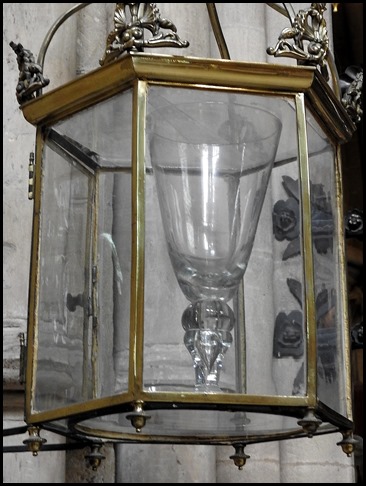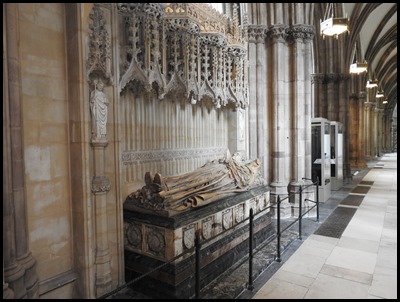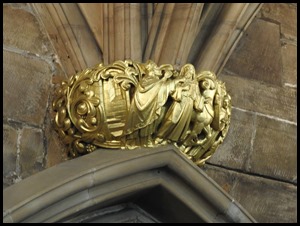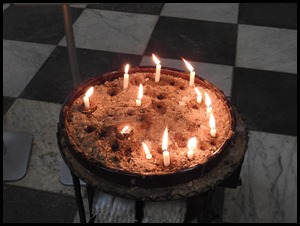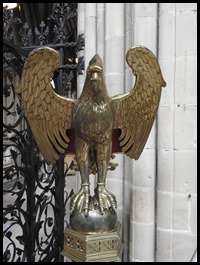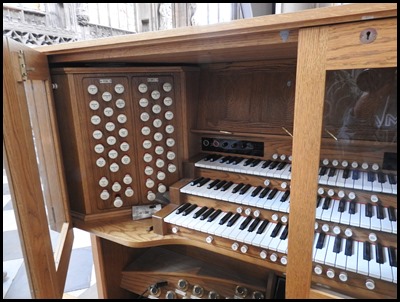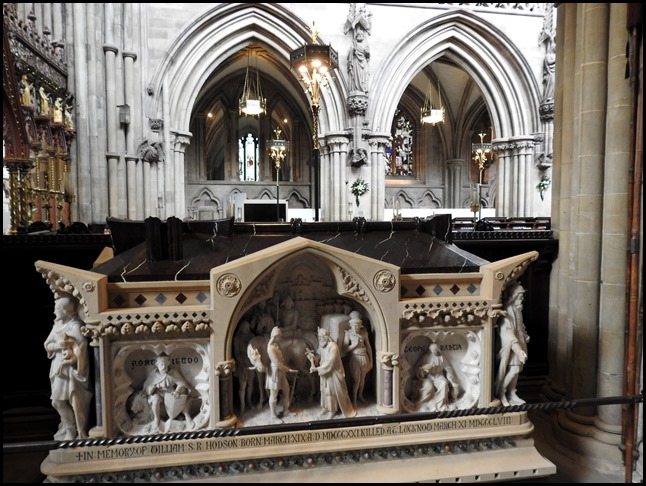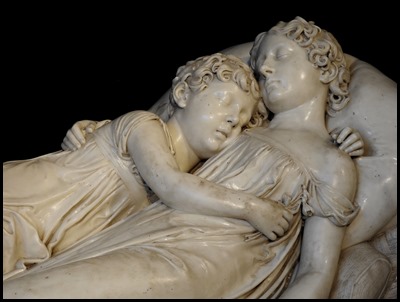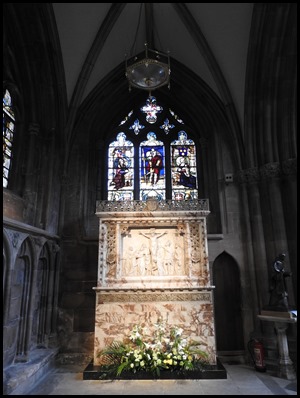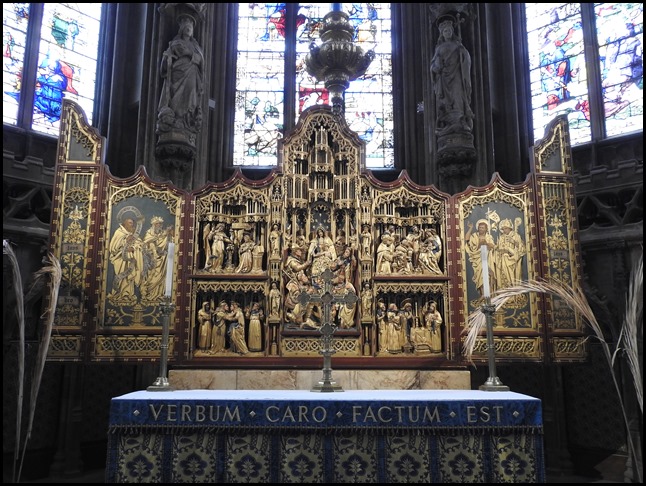Lichfield Cathedral

|
Lichfield Cathedral
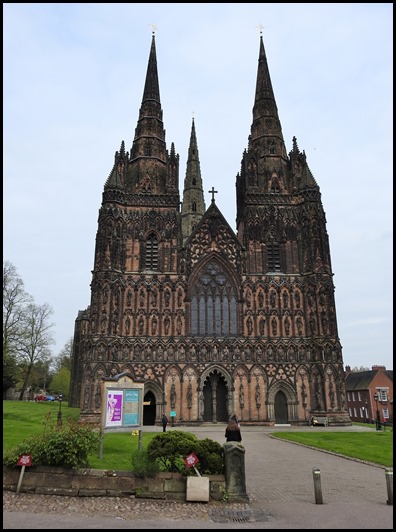 We bimbled just five minutes
from our B+B, turned left and wow, there in front of us the only medieval English
cathedral with three spires.
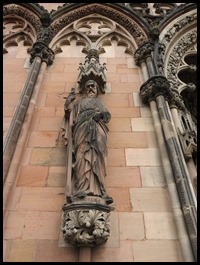    Amazing stonework.
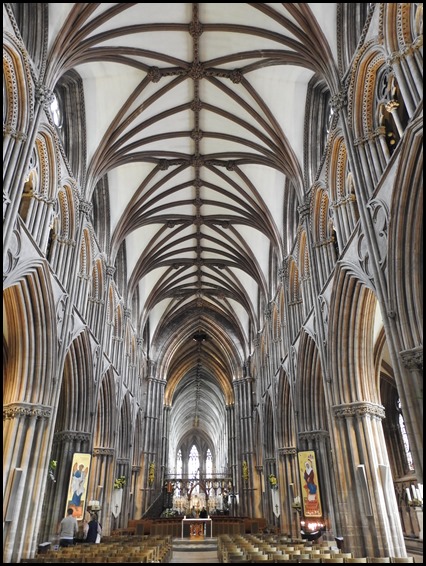 Beautiful
and huge inside.
   From the Cathedral’s website:Our History: Christmas Day 700 saw the consecration of the first
cathedral in Lichfield, and, as there was a church (St Mary’s) here perhaps
built in 659, and possibly others in between, Lichfield is among the earliest
centres of Christian worship in the UK. After the invasion of 1066 the
Normans built a new cathedral (of which only few traces remain), and a century
or so later that was rebuilt in the Gothic style, and completed by c.
1340. Besieged three times in the Civil War it suffered drastic damage,
more than any other of our Cathedrals. Rapidly repaired in a mere
nine years its interior was rearranged at the end of the eighteenth century, and
then ‘restored’ in the 19th century by Sir George Gilbert Scott, and that is the
Cathedral we have today. The only English medieval cathedral to have three
spires – known locally as the ‘Ladies of the Vale’ – it is one of the most
elegant in the country.
St Chad came in 669 to be the first Bishop in Lichfield, and so impressive was his teaching and so genuine was the way he practised what he preached, that on his death his remains quickly became venerated and a place of pilgrimage. Among the cathedral’s many treasures, from the time of the Anglo Saxons (probably under King Offa) we have the exquisite 8th century sculpture of the ‘Lichfield Angel’ from the St Chad’s tomb chest, as well as the St Chad Gospels - perhaps a little younger than the Lindisfarne Gospels but older than the Book of Kells.
Norman and Gothic Cathedrals: Bishops Lymesey and de Clinton built the Normal Cathedral and Clinton fortified the Close with a wall. In the 13th c. Bishop de Langton strengthened that surrounding wall for the Close and crenellated it; he paid £2,000 for a sumptuous shrine for St Chad, and he financed the completion of the Lady Chapel. He was also the Treasurer of England. His magnificent Bishop’s Palace in the Close was fit for a king, and kings did come to stay there. With very many pilgrims flocking to the shrine the cathedral flourished during the time of the Plantagenet kings. Many of the Bishops and Deans appointed then were Close to the ruling dynasty and the proximity of the Diocese to the rebellious Welsh made Lichfield a key strategic settlement during this period. It played an important role in regional and national political life and influenced heavily the planning of the City of Lichfield that grew up around it.
Civil War: Unfortunately the great wall around the Close proved to be the Cathedral’s undoing during the 17th century since it turned the cathedral and Close into an ideal garrison, first for the Royalists, then for the Roundheads, then again for the Royalists and finally the Roundheads until the Restoration. During these sieges cannonballs destroyed both the roof and the central spire. The Restoration (1660) found the cathedral and Close in a state of ruination, because the Roundheads had destroyed statues, monuments, documents, carvings and left very little roof. Lichfield’s cathedral suffered more than any other cathedral at the hands of the devastators.
Recovery Cathedral and Close flourished again in the 18th c. and grew in national importance, becoming a centre of culture and learning. With the development of Erasmus Darwin and his colleagues of the Lunar Society, Samuel Johnson and the great antiquarian, Elias Ashmole, Lichfield became a notable centre. Here was an interesting dynamic with religion and scientific advancement creatively interrelated alongside music, literature and culture, with Lichfield regarded as a major centre of enlightenment within Europe.
Victorian Restoration: A major and sensitive restoration of the cathedral came under Sir George Gilbert Scott and is son, Oldrid, in the 19th century. Outside statues were replaced on the West Front, and around the cathedral we now have over 160 ornate carved figures of kings, queens and saints. The cathedral’s interior today, with the very fine Skidmore Screen, the choir stalls and the Minton tiles (inspired by the medieval tiles still on the floor of the library) contains a singular composition of High Victorian artistry. The very recent relighting scheme means we can now see it in all its elegant glory. 2017: After all its often tumultuous, even savage, history Lichfield Cathedral today stands serene in majesty and lively in all its work and worship.
.
ALL IN ALL A BEAUTIFUL BUILDING VERY OLD AND INTERESTING |

